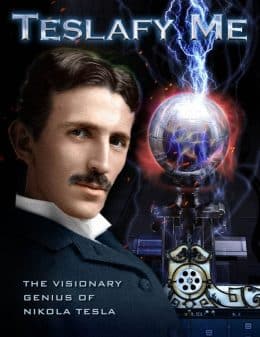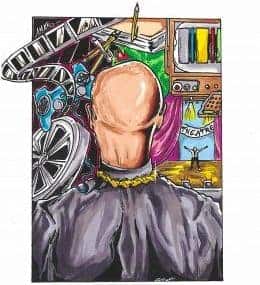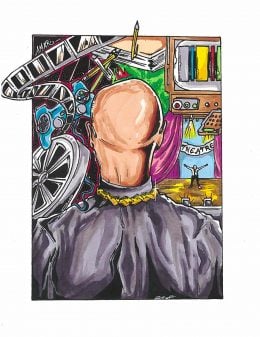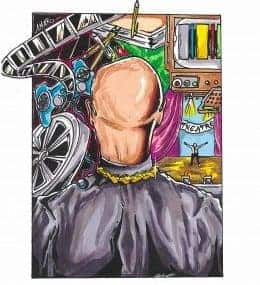Teslafy Me – Summary, Review (with Spoilers)
Teslafy Me explores the life of one of the 20th Century’s greatest inventors, and a forgotten genius – partly thanks to Thomas Edison.

Spoiler Alert: This summary and review contains spoilers.
Additionally, some images and text may include affiliate links, meaning we may earn a commission or receive products if you make a purchase.
Teslafy Me explores the life of one of the 20th Century’s greatest inventors, and a forgotten genius – partly thanks to Thomas Edison.
| Directed By | Janja Glogovac | |
| Written By | Janja Glogovac | |
| Date Released (Video On Demand) | 11/5/2019 | |
| Genre(s) |
|
|
| Noted Cast | ||
| Herself | Janja Glogovac | |
| Himself | William Terbo | |
| Himself | Michael Manske | |
| Himself | Paul Babcock | |
| Herself | Mira Fulan | |
| Himself | Branko Terzic | |
| Himself | Vladimir Pistalo | |
| Herself | Ksenija Misic | |
Plot Summary
A biography of the Serbo-Croatian scientist, inventor, and visionary, Nikola Tesla (1856-1943), and how his inventions are still a part of our lives some 76 years after his death. Best-known today as the brand name of a car, this documentary seeks to make people aware of how important he was in history and to make sure that we don’t forget it! Archival footage of his era, newspaper, and magazine articles and interviews, and comments from actors, musicians, inventors, and scientists, highlight how much Tesla was a visionary and an inspiration.
Collected Quotes by Nikola Tesla:
“If you want to find the secrets of the Universe, think in terms of energy, frequency, and vibration.”
“They called me crazy in 1896 when I announced the discovery of cosmic rays…. again, and again they jeered when I discovered something new and then years later saw that I was right.”
“The gift of mental power comes from God. Divine being, and if we concentrate on the truth, we become in tune with this great power.”
“My brain is only a receiver. In the Universe, there is a core from which we obtain knowledge, strength, and inspiration. I have not penetrated into the secrets of this core, but I know that it exists.”
“Energy of a single thought may determine the motion of a Universe.”
“The world is not ready for my inventions…too far ahead of its time.”
“The present is theirs. The future, for which I have really worked, is mine!”
[adinserter block=”34″]
Other Noteworthy Facts, Moments and Commentary
- Inventor of Alternate Current (AC) electricity.
- Inventor of the automobile automatic ignition system.
- He spoke over 6 languages.
- He made the cover of Time Magazine in 1931.
- In 1960, the General Conference on Weights and Measuresnamed the International System of Units (SI unit of magnetic flux density) the tesla in his honor.
Question(s) Left Unanswered
- What would life have been for Tesla, especially at the end of it, if he had gotten credit for, and was rightfully, and generously, compensated for his inventions?
- How different would the world have been if he succeeded in completing his Wardenclyffe Tower?
Review
Highlights
A forgotten genius whose many inventions are still in use today.
Born to an Eastern Orthodox priest father and a mother who was also an inventor, Tesla, from his earliest years, showed an interest in the cosmic power mother nature and in the Universe and how it could benefit mankind. One of his earliest inventions in his youth was a rudimentary water turbine, inspired from reading about Niagara Falls. Some 30 years later, his vision came to pass. He believed in wind power. “Imagine what energy is left unused with all this force at hand.” He was very in-tune with the frequency of the Earth, which at 7.83 hertz, is the same as the human brain.
[adinserter block=”35″]
He was a rival to Thomas Edison, and for most of the early 20th century, was one of the most recognized names in the world. He was intense, multi-lingual, cultured, was friends with two presidents and Mark Twain, but valued his solitude over companionship. He never married or had children. He was a man dedicated to his life’s work and learned to control his mind to focus on whatever idea came to him and how to bring it into reality. He would see a flash of light, then develop a migraine which would turn into the vision of the device which he would draw to detailed perfection.
However gifted, he found that others would take his ideas and would run with them to fame and fortune, which ended in his having many court cases regarding having to fight for the ownership of the patents of his inventions. Such was the case with Guglielmo Marconi, who was credited with inventing wireless communication, and for it, won the 1909 Nobel Prize in Physics. However, when Tesla was nominated for the Prize in 1937, he was not given it because the governing body deemed that his inventions were “old,” but admitted that he was a genius. (After his death, Tesla was awarded the credit for being the creator and owner of wireless technology and its patents by the Supreme Court).
In 1884, Tesla came to America to work for Thomas Edison, who became his biggest rival, after Tesla patented all the upgrades to projects that Edison had Tesla work on, but did not pay him for, and did all he could to discredit his work, especially his success with AC (Alternating Current) machine. Edison felt his DC (Direct Current) was more superior, and feared and hated Tesla’s AC machine, believing it to be a dangerous and deadly force, for which he experimented with in electrocuting a circus elephant and later inventing the electric chair. Thanks to the Edison Trust monopoly, which considered itself a protector of motion picture and recording technology patents, until it was dismissed by the Federal Government in 1915, there is no known film footage or recordings of Tesla in his lifetime—just photographs, magazine and newspaper articles.
[adinserter block=”36″]
Tesla’s biggest project was known as the Wardenclyffe Tower (1901-1917), an intercontinental wireless communication and power transmitter located in Shoreham, NY. With it, he desired to give the world FREE wireless technology but, unfortunately, ran out of money to complete it and couldn’t find anyone to finance the project after his main backer, financier J.P. Morgan, backed out of it. Living at the Waldorf Astoria Hotel in New York City on credit, Tesla lost his residence there when his benefactors died, and the new hotel owners wanted to collect on the rent, and he had no money to pay them. Tesla lost Wardenclyffe Tower, which was blown up, and the metal from it was sold as scrap iron. The building, though, currently stands and is listed on the national registry of historic places. The current owners hope to turn it into a Tesla Museum in the future.
Sadly, he began to be forgotten for his achievements, and the last 10 years of his life were fraught with court cases over his patents and J. Edgar Hoover’s FBI on his tail. In 1934, he earned a small stipend from the Westinghouse Electric & Manufacturing Company, founded by George Westinghouse, who Tesla teamed up with for the 1893 World’s Columbian Exposition in Chicago, IL. The company also paid his rent at the Hotel New Yorker, where Tesla died alone and penniless at age 85 in early 1943. His funeral was held at the Cathedral of St. John the Divine in New York City, which was attended by 2,000 mourners. All he had left at the time of his death were research papers and models of his inventions.
I thoroughly enjoyed this documentary, not only learning about Tesla’s life and inventions but how he was in tune with the Universe and was able to harness the power of his mind to bring forth all of his inventions.
[adinserter name=”Vidazoo”]
Overall
Met Expectations
Yes!
Would Watch Again?
Most definitely!! It was fascinating. Although I wasn’t good with science projects in school, I don’t mind watching content about famous men and women in that genre. I have gained a lot of respect for Tesla, but the film made me lose a lot of respect for Edison.
[adinserter name=”Follow Us”]
A forgotten genius whose many inventions are still in use today. - 95%
Met Expectations - 100%
Would Watch Again? - 99%
98%
Rating: Positive (Worth Seeing) - Recommended


